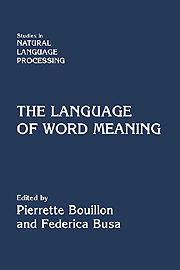Book contents
- Frontmatter
- Contents
- List of Contributors
- Preface
- Introduction: Word Meaning and Creativity
- Part I Linguistic Creativity and the Lexicon
- Part II The Syntax of Word Meaning
- Part III Interfacing the Lexicon
- Part IV Building Resources
- 18 Introduction
- 19 Generative Lexicon and the SIMPLE Model: Developing Semantic Resources for NLP
- 20 Lexicography Informs Lexical Semantics: The SIMPLE Experience
- 21 Condensed Meaning in EuroWordNet
- Index
21 - Condensed Meaning in EuroWordNet
Published online by Cambridge University Press: 07 October 2011
- Frontmatter
- Contents
- List of Contributors
- Preface
- Introduction: Word Meaning and Creativity
- Part I Linguistic Creativity and the Lexicon
- Part II The Syntax of Word Meaning
- Part III Interfacing the Lexicon
- Part IV Building Resources
- 18 Introduction
- 19 Generative Lexicon and the SIMPLE Model: Developing Semantic Resources for NLP
- 20 Lexicography Informs Lexical Semantics: The SIMPLE Experience
- 21 Condensed Meaning in EuroWordNet
- Index
Summary
Abstract
This chapter discusses condensed meaning in the EuroWordNet project. In this project, several wordnets for different languages are combined in a multilingual database. The matching of the meanings across the wordnets makes it necessary to account for polysemy in a generative way and to establish a notion of equivalence at a more global level. Finally, we will describe an attempt to set up a more fundamental ontology, which is linked to the meanings in the wordnets as derived complex types. The multilingual design of the EuroWordNet database makes it possible to specify how the lexicon of each language uniquely maps onto these condensed types.
Introduction
The aim of EuroWordNet is to develop a multilingual database with wordnets in several European languages: English, Dutch, Italian, Spanish, French, German, Czech, and Estonian. Each language-specific wordnet is structured along the same lines as WordNet (Miller et al., 1990): Synonyms are grouped into synsets, which are related by means of basic semantic relations such as hyponymy (e.g., between “car” and “vehicle”) or meronymy relations (e.g., between “car” and “wheel”). By means of these relations all words are interconnected, constituting a huge network or wordnet. Because the lexicalization of concepts is different across languages, each wordnet in the EuroWordNet database represents an autonomous and unique system of language-internal relations. This means that each wordnet represents the lexical semantic relations between the lexicalized words and expressions of the language only: No artificial classifications (such as External-Body-Part, InanimateObject) are introduced to impose some structuring of the hierarchy (Vossen, 1998; Vossen and Bloksma, 1998).
- Type
- Chapter
- Information
- The Language of Word Meaning , pp. 363 - 384Publisher: Cambridge University PressPrint publication year: 2001
- 2
- Cited by



